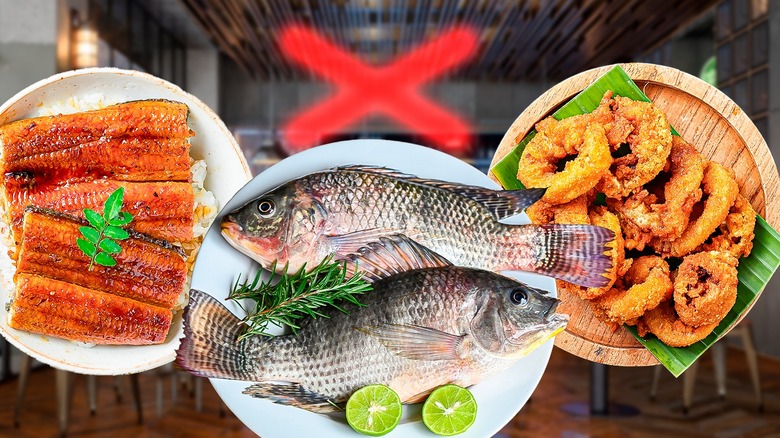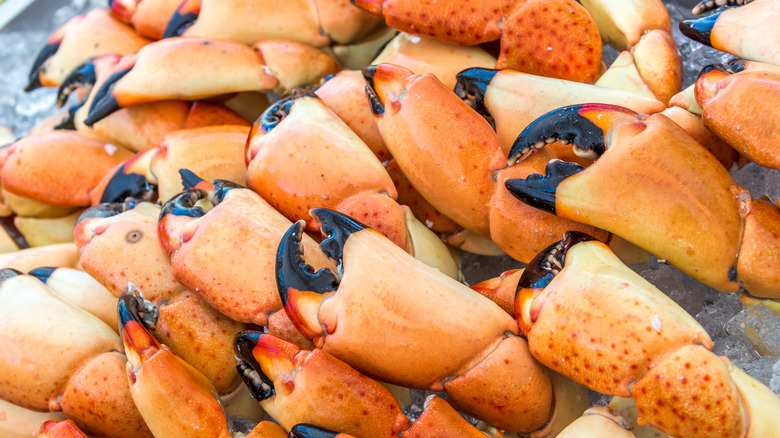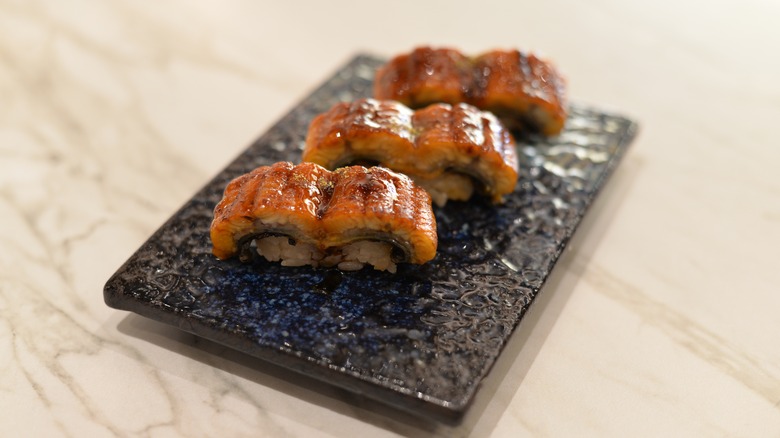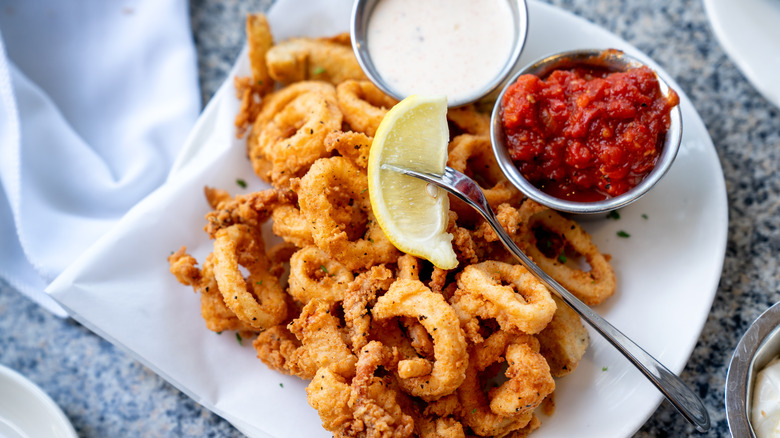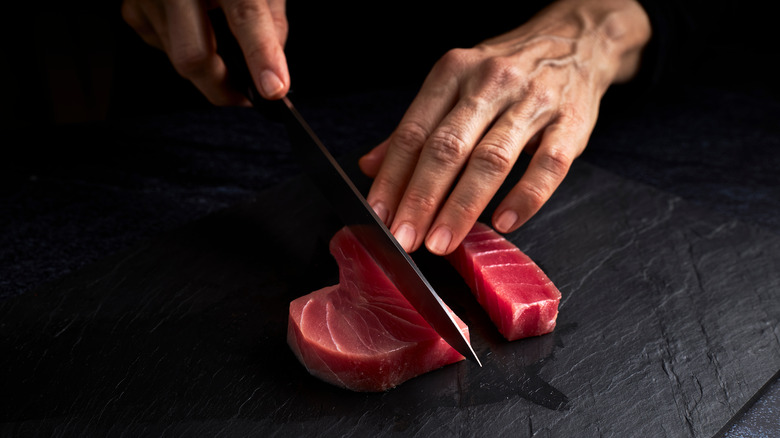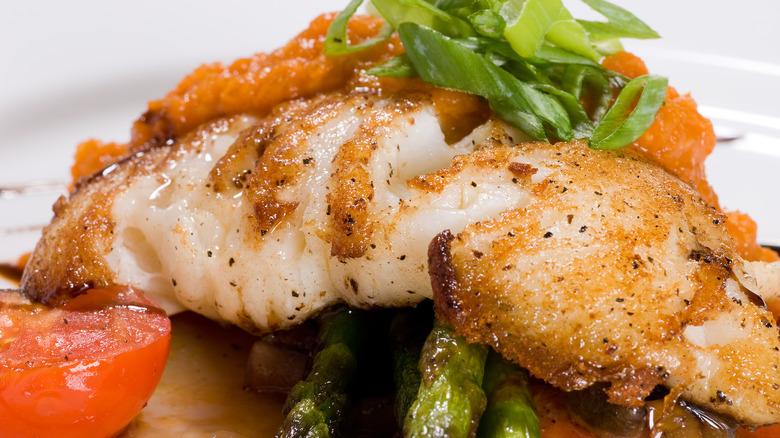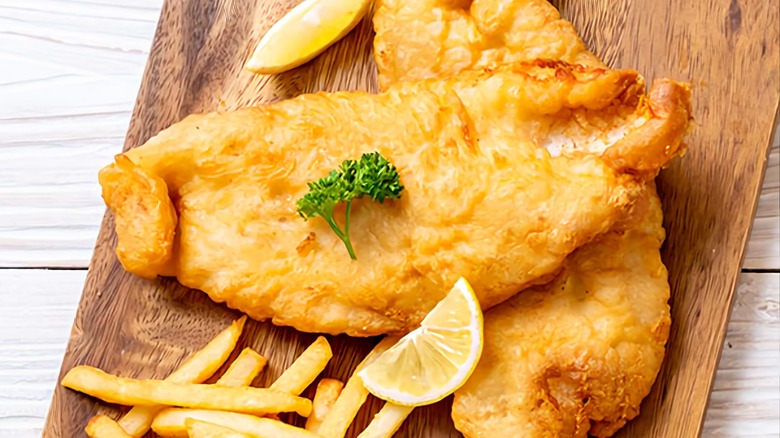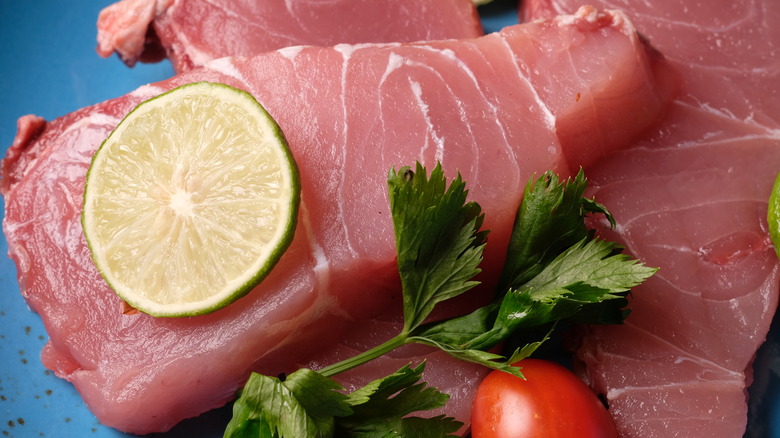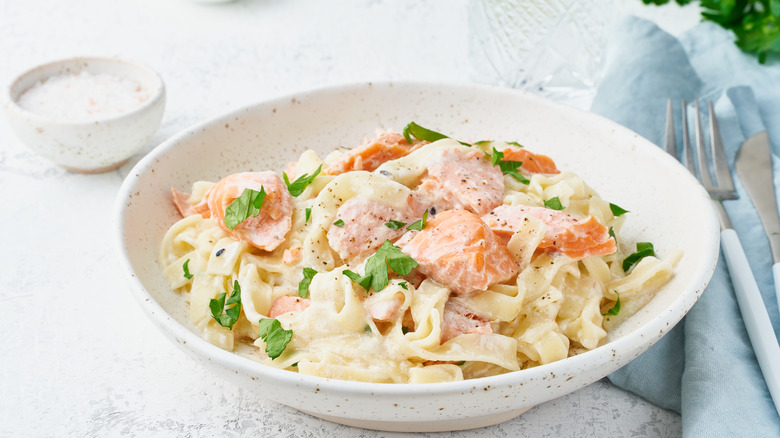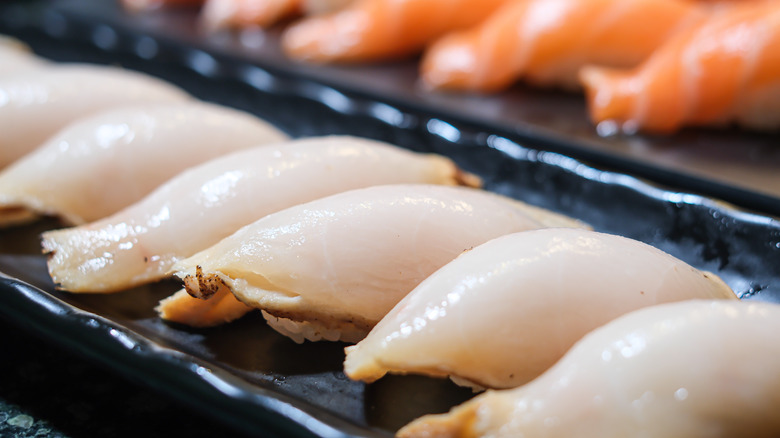13 Dishes You Should Never Order At Seafood Restaurants
If only ordering at a seafood restaurant is a simple, transactional affair, but in reality, there is much to consider.
For one, I've witnessed occurrences that would give customers pause or send them running throughout my 35 years of experience as a chef and restauranteur. Common unethical practices like misrepresenting the fish on the menu or camouflaging seafood clearly past its prime are probably why Anthony Bourdain advised never to order fish on Monday, as you'd probably be eating Friday's fish. He walked that statement back when food standards improved, but it remains in the heads of many consumers.
Another consideration is the impact of consuming heavy metals, mercury, or polychlorinated biphenyls (PCBs) on our health. The United States Environmental Protection Agency (U.S. EPA) lists cancer, reproductive, and neurological effects as just some of the possible health problems arising from inadvertently consuming PCBs via food sources like fish. Diners also have to take into account the impacts of overfishing and farming seafood.
Thus, I ensured the seafood sold in my restaurants came from verifiable, sustainable sources by working with the Smart Catch program. Backed by the James Beard Foundation, it's an educational program working toward global seafood sustainability. Much of the popular seafood we enjoy is under pressure, overfished, or endangered, and raising public awareness of this leads to consumers making more mindful choices. Considering quality, health, and sustainability, we arrived at this list of dishes you should steer clear of on your next visit to a seafood restaurant.
1. Tilapia
Tilapia is a popular fish, especially among those who don't like fishiness, due to its mildly sweet taste and flaky texture. This fish is almost exclusively farm-raised, and its feed dictates its flavor. Farming tilapia comes with two significant concerns.
The first and most significant is that without proper water circulation and treatment, a tilapia farm can pollute the water and negatively impact natural habitats. The second is the potential of introducing invasive species into ecosystems.
Then there's the notion that all fish is good for you. Tilapia isn't bad, per se, but because of its commercial feed of corn and soy, tilapia is low in beneficial omega-3 fatty acids. Farmed tilapia is often high in omega-6 fatty acids, which can possibly increase inflammation and contribute to other health problems, according to American Oceans.
Not all farmed tilapia is terrible; the country of origin can affect the quality because of stricter rules and practices in some locales. Seafood Watch recommends tilapia from Ecuador and Peru, with Honduras, Indonesia, Colombia, Mexico, and Taiwan following. It suggests avoiding Chinese tilapia due to poor farming practices and health risks. If you can't determine the origin, it's best not to risk it.
2. Stone crab
Seafood Watch considered the stone crab a highly sustainable species before 2018 rolled around. It's necessary to explain the unique harvesting practice to understand the change in opinion.
Each fall, Floridians eagerly await the harvesting season of stone crabs, starting in mid-October and lasting until the beginning of May. Stone crabs are harvested for their claws and returned to the water after removal. Crabbers formerly removed one claw only, which would regrow with time, and the crab still had the other claw to feed and defend itself. Regulations changed, and taking both claws is now permissible, provided they're of legal size. It turns out that stone crabs aren't as resilient as previously thought, as the mortality rate is 40% for crabs that lose one claw and 60% for those with two claws removed, per Florida Sea Grant. This policy change caused Seafood Watch to change its environmental sustainability rating for stone crab from "Best Choice" to "Avoid."
Stone crab demand has increased as catches have decreased and new regulations call for larger legal claw sizes for harvest. These factors combined raise the cost of the claws, reaching wholesale prices in 2023 of $35 per pound for roughly three claws and $75 for colossal sizes. If the environmental impact doesn't move you to seek alternatives, the price may do that for you.
3. Eel
Eel — unagi in Japanese — is most commonly found on sushi menus in the U.S. It's typically grilled and bathed in a sweet sauce of mirin, rice wine, sugar, and soy sauce. The biggest reason for cooking eel, rather than serving it raw like many other types of seafood in sushi, is that one of the eel's natural defense mechanisms is its toxic blood, which becomes safe for consumption when fully cooked.
That's not what makes it questionable, though. According to Sustainable Sushi, wild eel populations are in severe decline, leading to eel farming as a solution. But raising eels on a farm comes with several negative consequences. First, they require fish protein to grow, and farmers rely on local wild fish populations to feed their eels, which puts pressure on those populations, as it takes about 2.5 tons of fish feed to produce 1 ton of marketable eels. Those eel farms have to be located near a water source, leading to the destruction of wetlands and furthering pressure on the local fish population. Most eel farms are located in countries with less-than-stellar regulations on fish farming, and the farms pollute the wild habitat on top of the destruction of the wetlands. Eels are also well-known escape artists; trouble follows when they get free. Diseases aside, the farmed and local wild eels aren't of the same genetic line, and interbreeding changes the future breeding capacity in the wild.
4. Fried calamari
While there's nothing inherently wrong about squid, what we do to it makes it worthy of questioning when encountering it on a menu. Squid was considered bait in the U.S. until about 50 years ago when fishing regulations changed, and fishers had to pivot to find a new species to harvest. Through a careful marketing spin, Americans got familiar with this now ubiquitous squid dish and its preparation by its Italian name, calamari fritti.
The breading for this dish is typically thick, providing more surface for the flour to absorb the fryer oil. The result of this thicker breading is a high-calorie, high-fat dish that one might not consider nutritious.
Taking Red Lobster's Hand-Breaded Calamari starter as an example: One serving packs 1,000 calories, 90% (70 grams) of the daily recommended amount of fat, 227% (680 milligrams) of the daily recommended cholesterol intake, and 90% (2,070 milligrams) of the daily suggested sodium consumption. You might have to significantly adjust the rest of your dietary intake to enjoy this plate of fried seafood.
But nothing says frying calamari is the only way to enjoy it. Italians and many other cultures prepare squid by stuffing, braising, or grilling, which can make it a healthier choice, as this Thai-style grilled squid salad demonstrates.
5. Pacific bluefin tuna
Bluefin tuna is one of the most sought-after sushi dishes because of its flavor, texture, and fat content. Bluefin tuna is particularly prized for parts like otoro (fatty belly) or chu-toro (medium fatty belly). Unfortunately, Pacific bluefin populations are burdened and close to unsustainable. The Marine Conservation Society explains that overfishing of bluefins in all areas of the Pacific outpaces births of new tuna. But it notes the populations are "beginning to recover" — not to be confused with "recovered."
Purse seines, which are large nets used to encircle schools of fish before scooping them out of the water, are used as a fishing method for bluefin tuna, according to the National Oceanic and Atmospheric Administration (NOAA). Purse seines don't discriminate and corral anything inside the net onto the fishing boat. Anything caught unintentionally in commercial fishing is called bycatch, and mortality rates for bycatch are staggeringly high. Bycatch in purse-seining Pacific bluefin tuna includes sharks, turtles, and marine mammals, unintentionally putting pressure on those populations. Another common fishing method for Pacific bluefin is longlining. This method is exactly like it sounds: horizontal lines up to 70 miles long with vertical hooked lines hanging from them. Longlining is even more indiscriminate of bycatch, making both popular methods hard on not only tuna but multiple other species. Putting these factors together makes bluefin a fish to avoid.
6. Shark
Shark populations see a lot of stress due to the practice of finning. The practice involves removing the sharks' fins, often while still alive, because the fins bring more money than the other body parts and it's easier to store and transport the fins than the whole carcass on a boat. The fins are often used to make shark fin soup — a Chinese cultural status symbol thought to have medicinal properties. It contributes to the shark fin trade, which accounts for many of the 100 million sharks killed annually around the globe, per the Smithsonian Institution.
Although Seafood Watch lists certain shark species as a "Good Alternative" — meaning they're okay to eat, but there are better choices — justifiable concerns surround them. Longlining as a typical means of capture means heavy bycatch, making shark meat even more problematic as many non-targeted species die in the process. Shark fins are banned in the U.S., and while shark meat is not as prevalent on American menus as in the past, shark is most commonly prepared fried or grilled and often found in imitation crab meat.
7. Red snapper
The red snapper is only a sustainable option depending on the catch location's population. Compounding that is the rampant mislabeling of red snapper. A National Library of Medicine study revealed that 90% of the red snapper sampled from menus and grocery stores in North Carolina were other snapper species or even tilapia, which comes with its own set of problems. A 2019 CNN report showed that mislabeling was commonplace in a larger sampling that spanned 24 states. The National Institutes of Health (NIH) found that among the most commonly mislabeled fish are red snapper and grouper, given the high dollar value of each species. The report shows that swapping a different species but charging the same menu price can result in up to 244% cost difference for the swapper.
Because it's difficult to tell one piece of fish from another after it's cooked, it is good practice to order red snapper when it's prepared skin-on. The distinctive red skin coloring doesn't wholly fade when it cooks, and peeking at the skin can help ensure you get what you've paid for.
8. Catfish
Wild and farm-raised U.S. catfish are excellent, very sustainable options. However, they tend to be more expensive than those you shouldn't order. Hence, it was once commonplace to label Vietnamese-raised swai, a distant, cheaper relative of catfish, as catfish.
However, regulations changed, reserving that catfish label for members of the Ictaluridae family on wholesale packaging. But that doesn't mean the restaurant selling "catfish" is not substituting it for swai.
U.S. farm-raised catfish is one of the most sustainable species available. Catfish ponds are enclosed, self-contained, and far from protected wetlands or polluted and contaminated areas, so it has minimal influence on the surrounding environment.
On the other hand, farmed swai is highly problematic. The issues start with lax regulations and inspection procedures and continue through the destruction of wetlands. Antibiotic use is high in these industrial farms, which means contaminated swai. Recirculation and filtration systems are lacking in the chief swai-producing countries, so the fish essentially live in a sewage plant. The wastewater can seep into the ecosystem and nearby waterways, affecting native wildlife and fauna. So, question your server about the origin of the "catfish" before ordering. Don't hesitate to eat domestic wild or farmed fish, but avoid anything unclear about its provenance.
9. Atlantic cod
Cod is an excellent fish to eat and can be from a sustainable fishery, but you'll have to ask. Pacific cod fisheries around Alaska and the west coast of the U.S. are considered well-managed and certified by the Marine Stewardship Council. Atlantic cod, however, don't share the same designation.
While they were once so plentiful to provide a way of life for early Massachusetts settlers (Cape Cod, anyone?), Atlantic cod populations have dwindled so significantly that NOAA considers the population overfished and subject to further overfishing. Atlantic cod is making a comeback but will require less pressure on its numbers to recover substantially.
Please don't rule out all cod because of the disparity in their sustainability. Ask your server to verify the sourcing and eat the Pacific variety with no qualms. How do the two types of cods differ in taste? Atlantic cod is a smaller, sweeter-tasting, flakier fish than its Pacific cousins, which tends to fall into chunks more than flakes. These characteristics mean Pacific cod is equally suitable for baking, grilling, or battering for fish and chips, which is a frequent preparation for its Atlantic counterparts.
10. Swordfish
Swordfish is an excellent source of lean protein, but it comes with a few problems that could, or, in some cases should, put you off the idea of ordering it. We'll start with a warning from the U.S. Food and Drug Administration (FDA). It recommends that those who are pregnant or might become pregnant, breastfeeding, or 11 years old and under avoid swordfish altogether.
Swordfish are apex predators, meaning they eat many smaller fish. According to Healthline, those smaller fish carry a small amount of mercury that builds up in the swordfish's bodies. Mercury can harm brain development even at low levels, per the Rhode Island Department of Health. Keeping unborn and young children's exposures to a minimum protects their health.
Another issue with swordfish is parasitic worms in the meat. Anthony Bourdain exposed this swordfish secret in his book "Kitchen Confidential: Adventures in the Culinary Underbelly." Swordfish frequently carry ascarids — related to the trichinosis-causing parasites sometimes found in pork. They can die after exposure to heat at or above 145 F, but cooking fish to that temperature destroys most of what's good about eating fish. So, child or not, it might be better to forgo any swordfish crudo preparations.
11. Marlin
Marlin, which belongs in the same family as sailfish, is another problematic fish for two reasons. The first is sustainability. The Atlantic blue marlin, found in the Atlantic Ocean and the Gulf of Mexico, is overfished, according to the Pew Environment Group. Overfished refers to the catch rate exceeding the birth rate, resulting in the fish being listed as vulnerable to extinction. On the other hand, NOAA considers Pacific blue marlin a "smart seafood choice" because it's neither overfished nor subject to periodic overfishing. But it's best to pass it up if you can't verify the fish's origins.
The other key consideration is the marlin's position at the top of the food chain. All those smaller fish that it eats cause high levels of mercury, and marlin is on the FDA's list of fish to avoid for pregnant, nursing, or soon-to-be-pregnant people, as well as children 11 and under.
12. Seafood pasta
Generic seafood pasta is the modern equivalent of the fish specials chef Gordon Ramsay warned about. If the menu doesn't lead with the specific type of seafood and pasta used in the dish's preparation, it could be a dumping ground for fish scraps. For example, compare "Seafood Pasta" to "Spaghetti with Clams and Green Olives" as menu titles. The former is generic, while the latter is a very intentional combination of a particular pasta, specific shellfish, and the accompanying ingredients. Which inspires more trust from you?
Shrimp and shellfish move quickly, so you don't need to worry much about their freshness. The fish found in these pasta dishes are typically scraps from cleaning and portioning fish for the menu and aren't inherently bad, as they're simply bits of perfectly good fish that aren't big enough to serve as a portion. But they get treated with little respect after cutting. Often not rotated and subject to mistreatment, they're frequently on the verge of spoiling. Cream is a powerful mask for such fish, so kitchens often hide these fishy ingredients under a creamy, cheesy sauce with some grated cheese garnish for additional masking.
13. White tuna
White tuna isn't tuna at all. It's a bycatch of the tuna fishing industry. It started appearing on restaurant menus in the 1990s after someone decided to capitalize on this incidental fish under its true name of escolar, nicknamed oil fish or butterfish.
According to California Sea Grant, escolar's body composition is about 20% wholly indigestible waxy esters — large oil molecules — which have a laxative and purgative effect on humans when eating too much. As such, the maximum recommended portion for this high-protein fish is 6 ounces.
Escolar's negative effects on humans and frequent deceitful mislabeling as white tuna, especially on sushi menus as sashimi or in rolls, earned escolar a ban in Italy and Japan. Since escolar's presence in markets and menus arose as a money grab for bycatch, you can reasonably pass this fish without causing any disruption in the natural order of things.
